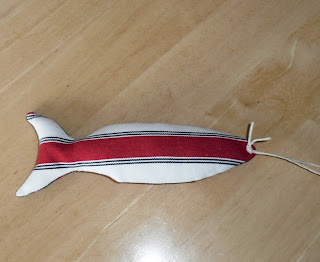I was surrounded by some terrific designers and makers, and it was great to meet them after admiring their work on line. All in all a very good weekend.
When I wasn't talking to visitors and admiring other stalls I did a little making as I took some sewing with me. I think it looks good to be busy behind your stall. This is something I should add to my list of things to take to a fair -it nice at fairs to be demonstrate your crafting skills to visitors if you can. Unfortunately the sewing machine doesn't travel well so I usually take some hand sewing, something small that is is easy to put down and doesn't take too much concentration. This weekend I made some little fabric brooches while I was sitting behind the stall.
This is an incredibly simple idea and very easy to do, and like many things I mentioned previously easy to adapt and develop. The basis of the brooch is a 'yoyo' or I've also heard them called 'suffolk puffs', I think the names are quilting terms although I may be wrong.
The basis of the brooch is a circular disc of fabric, the size of the disc determines the size of your brooch.
Sew a small running stitch around the edge of your disc about 0.5cm from the edge. Running stitch is a very simple in and out straight stitch, make sure the end of your thread is well secured when you start sewing so when you have completed stitching round the edge of the disc and pull the thread the fabric gathers up.
This will bring the outside edge of the disc together, make sure the right side of the fabric is facing outwards, and manipulate the fabric disc so the gathered edge sits in the centre of the disc and secure and trim the thread.
Add a button and sew on centrally to hide the raw edge. Then you can just attach a brooch bar or a small safety pin to the back so you can wear your brooch.
So what about adapting the idea;
-you could sew a couple of yoyos in complimentary fabrics (one larger than the other) on top of one another to make a bigger brooch.
-the yoyo with the central button resembles a flower so you could make some green felt leaves and sew them to the back of the yoyo before adding your brooch bar.
-to accentuate the shape of your yoyo flower you could add a little stuffing, do this as you are drawing up the running stitch so you can secure the stuffing inside.
- you could sew several together so it appears to be several flower heads together, use a piece of heavier fabric or heavy interfacing to sew the yoyos to then sew your brooch bar to the back of this piece of fabric.
-rather than making a brooch sew several yoyos together and make up into a necklace.
This make is another way of using up scraps of fabric- the brooches (or if you developed the idea your yoyos may have multiplied to a full blown corsage) are great on jackets, cardis, hats and even bags. I've started adding these brooches to some my bags- making them up it the same fabric as the bag lining and using some big interesting buttons in the centre of the brooch. It is actually quite a nice way of showing off vintage, antique, or just nice buttons.





















